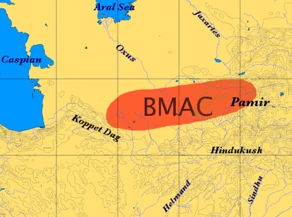Brief Identification[]

Bactrian Princess
The Bactrian Princess is a small (18.3cm high) composite figure that consists ofdetachable parts. It was discovered in 1976 by Soviet archeologistViktor Sarianidi in the Karakum Desert in Turkmenistan. The object is from the Bactrian-Margiano civilization and dates back to between 2200 BCE-1700 BCE. Bactrian Princesses were sometimes representations of aristocratic ladies but usually they were a representation of a goddess , who in central Asian mythology, played a regulatory role over the natural world.
Technical Evaluation[]
The Bactrian Princess was made up of detachable parts. The most common stones used in the creation of the princess were steatite and calcite which are both common stones in the region of the Bactrian empire (See Morrey 1994, 45). The green steatite was used to make the garments, headdress and/or hair. The white calcite was used to make parts of the body. The two differing colors of the respected stones allow for a distinct contrast in color and brings attention to the fine detail which the Princess possesses. The skirt of the Princess is thought to be inspired by a traditional piece of Sumerian clothing called a Kaunakes , a skirt with long overlapping tufts. The upper body of the princess was patterned using hatchingand chevron techniques.
The Bactrian civilization was a traditional Bronze Age civilization and thus had access to Bronze Age technology in order to construct such an ornate object. However, the Bactrian Princess was constructed in accordance to a very high standard and consequently took a long time to complete. The head and neck piece was crafted to fit exactly into the neck opening of the dress, so attention to detail was essential.
Today, there are known to be at least 38 Bactrian Princesses in existence in both museums and private collections. The Louvre, Ancient Orient museum and the Miho museum all have a Bactrian Princess in their possession. Recently, art collector Max Palevsky passed away and a Bactrian Princess that was in his private collection is now up for auction.
Local Historical Context []
The Bactrian Princess was created by the Bactria-Margiano Archeological Complex, or BMA

General Location of the BMAC
C, which was primarily located in the Oxus Valley. While we can only glimpse at the cities that made up this ancient central Asian civilization, findings due reveal a series of cities, each with temples , administrative quarters and defensive walls. These cities were dependent on oasis's since they primarily resided in very arid regions. However, the people did have a fairly sophisticated system of irrigation . Much of what we know is from archeological digs and ancient burial sites (see Dani, 1992, pg 379-395) where pottery and remains have been located.
[1]General location of the BMACAdded by Matthewd1225The people who made up the BMAC were sedentary farmers who practiced irrigated wheat and barley farming . Also, they were far from isolated, with evidence of interaction with nomadic tribes from the Asian steppes . This conclusion is re-affirmed by the archeological findings of pottery in BMAC territory that was common to the nomadic people who inhabited the steppes.
The Bactria-Margiano Archeological Complex exhibited many of the characteristics that define a civilization. Their civilization included monumental architecture, Bronze Age tools, pottery, ceramics and jewelry made out of precious stone. Also, a tiny stone seal was discovered in 2001 in Turkmenistan that had geometric carvings on it. This discovery led some to declare that the BMAC had in fact developed a writing system and that they should be classified as a literate society. However, it is not clear if this is in fact proof of a writing system, or of isolated pictographs that resemble some found in ancient Chinese culture and used some 2500 yearsago
World-Historical Context[]
It is debated amongst scholars as to what exactly the Bactrian Princess represents . As it has the word princess in its name, some scholars believe it to be a representation of noble women. The only complete Bactrian Princess that was discovered in an archeological dig did come from a grave of what is believed to be a noble woman, further strengthening this hypothesis. However, others believe that the Bactrian Princess is a representation of an Asian goddess who was paramount to Central Asian mythology, and regulated the natural order, pacifying theuntamed forces embodied by lions, snakes or dragons.
Similar figures have been found on seals that were discovered in southwest Persia. Sometimes, a similar figureappears flanked by or seated on animals or mythical creatures. These attributes could in fact indicate a divine quality associated with the figure. Furthermore, the Bactrian Princess served a similar function to other statuettes throughout world history. If in fact it was a representation of a divine being, then it can be likened to statues of any other religious nature such as a Buddha statue, a statue of Jesus Christ, or an ancient Greek god. If it was in fact a depiction of a royal and noble woman, then it can be likened to statues of other great or noble women of the time.
Bibliography[]
Morrey , P.R.S. Ancient Mesopotamian Materials and Industries: The Archaeological Evidence. Winona Lake: Eisenbrauns, 1994.
Dani, A.H, and V.M Masson. History of civilizations of Central Asia Volume I The Dawn of civilization: earliest times to 700 B.C. Unesco, 1992.
Musee Barbier Mueller, "Female Statuette"
http://www.barbier-mueller.ch/collections/antiquite/proche-orient-au-iiie-millenaire/
The Louvre, “Composite Female Statuette”
http://www.louvre.fr/en/oeuvre-notices/composite-female-statuette
Collector Antiques
http://www.collector-antiquities.com/514/
Global Security, “BMAC”
http://www.globalsecurity.org/military/world/afghanistan/history-bmac.htm
Christie's, "Bactirna Stone Female Compiste Figure"
Roman History and Culture, "BMAC"
http://www.romanianhistoryandculture.com/daheansmargiana.htm#638792704
Wmagazine, “Art, Drugs and Rock ‘N’ Roll”
http://www.wmagazine.com/artdesign/2010/11/max_palevsky_art_auction